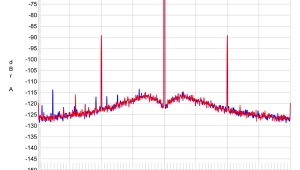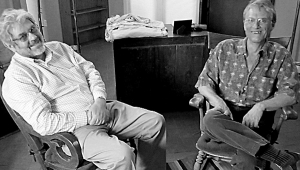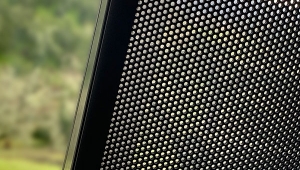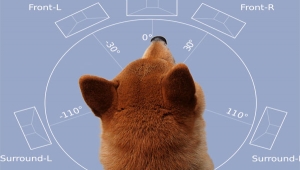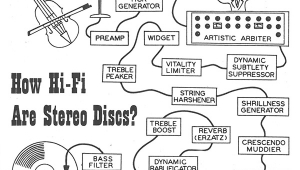| Columns Retired Columns & Blogs |
The Nonstick Embrace Of Home Theater

Editor's Note: 24 years ago, in January 1995, we published the first issue of Stereophile Guide to Home Theater, a sister publication intended to appeal to the the growing number of home-theater enthusiasts. Stereophile's founder, the late J. Gordon Holt, had gotten early into the idea of accompanying movies with high-quality sound, and when I first visited his New Mexico home in January 1986, his system included an Advent NTSC-format video projector. Gordon and I went back and forth over the next few years, arguing about the role video played in a music-lovers system—click here and here—but his passion eventually won me over. Here is the editorial leader I wrote for that very first issue, to accompany Gordon's major feature on home theater from the same launch issue of SGHT.—John Atkinson
"Kerr-Clunnnk!" Arnold Scharzenegger cocks his shotgun in Terminator 2. "Whizzzzzz—Crash!!!!" Dennis Hopper's terminally targeted elevator plunges 30 storeys to the ground in Speed. "Rooooooar-Booooom!!!" The bass-heavy boulder in in the panther cave pins Aladdin's magic carpet to the ground. "Thud . . . thud . . . thud!" go the ominously earthshaking T Rex footsteps in Jurassic Park. Cinemas are becoming increasingly noisy places these days.
And let's not forget the quiet sounds: the chink of the golden idol at the start of Raiders of the Lost Ark; the background rustle'n'bustle in the pivotal courtroom scene in Patriot Games; and the all-around hum in the Starship Enterprise's bridge. These sometimes barely discernible sounds, mixed into every film's soundtrack by an army of Foley artist and sound-effects engineers, help envelope the viewer in the on-screen action.
I was recently reminded of this when I went to see Quiz Show. I had missed Robert Redford's fable of modern morality in its first-run house, catching it instead in a typical 60-seat mall shoebox. As the first reel unwound—yes, I know, they're "pancakes" these days, not reels—I was increasingly bothered by one small detail. Yes, the projectionist had for once caught the correct focus on the projector. No, there was no sticky soup of Coke-impregnated popcorn underfoot, and—a miracle—there was no chewing gum on the seat. But the sound, as it is in the majority of small cinemas across the land, was mono.
Instead of the action reaching out to me, the surrounding sound gently blurring the edges between on- and off-screen realities, the action remained doggedly bound by the edges of the screen. I remained a voyeur of, not a participant in the movie's magic.
A movie's images need the soundtrack's help to fully come alive. Without stereo, without surround sound, it's much harder to ignore the chewing gum, the sticky floor, the uncomfortable seat, and the cacophony of coughs and cackles from your neighbors; to suspend your disbelief and cross that magic line defining, in the words of sound engineer Kurt Graffey at the 1994 Audio Engineering Society Convention, "the leaky dimensionality at the edges of the visual window." Without high-quality audio, video adamantly remains eye candy.

As I left the cinema, the thought "can't wait to see this at home flashed through my mind. For at home there need be no restrictions, no discomfort. The sound of a modern home theater system can be both more neutral and more enveloping than any cinema; the image, once restricted by the NTSC Standard from the 1950s, can be enhanced by the use of line-doublers, and the Coke'n'popcorn stay in the bucket!
Ironically, the movies were pioneers in the use of sound to envelop their audiences, developing commercial multi-channel playback well before music reproduction systems. From the multi-channel but not-stereo soundtrack of Fantasia in 1940, through the true stereo of Carmen Jones and the five channels of The Robe in the '50s, high-energy audio was seen as one answer to the commercial challenge presented by television.
Other answers of course, were the advents of Cinemascope, Cinerama, 70mm film, etc, to enhance the visual aspect of the movie experience. But most of the movie palaces went belly-up in the '60s, and the mall multi-screens that replaced them in the '70s gave sound a very low priority. Not until 1977—when George Lucas produced the first Star Wars movie, with a soundtrack to match the quality of the images—and the early '80s, when Dolby showed how twin optical film soundtracks could carry full surround-sound, did quality audio once again catch the attention of filmmakers. But now there were new home media—video cassettes and laserdiscs—and domestic audio systems capable of handling the demands of movie sound. And the projection TV, once a dim and dimwitted cousin of the bright, sharp direct-view monitor, has developed by leaps and bounds.
Yes the birth of home theater was difficult and long—it was nigh on 15 years ago, in the early '80s, that I attended a reception to launch the laserdisc, but in the '90s, the concept has caught fire. Which means, of course, that there must be magazines about home theater. And the 1995 Stereophile Guide to Home Theater, which you now hold in your hands capably crafted by Editor Lawrence B. Johnson, echoes everything that has made Stereophile the preeminent magazine covering home music reproduction.
You'll find in-depth reviews by knowledgeable writers who are encouraged to write what they think, unencumbered by commercial considerations. You get reviews in which components are primarily judged on how they sound and look, not on whether they meet arbitrary technical specifications. You can read articles on how to set-up your home-theater system to get the best from it.
And, last but not least, the Guide is permeated by the inimitable presence of J. Gordon Holt, Stereophile's founder and one of the first audio writers to preach the merits of the marriage of audio and video.
Enjoy!—John Atkinson
Postscript: Stereophile Guide To Home Theater grew over the following years. Following its Winter 1997 issue, devoted to the launch of DVD and almost entirely written by Thomas J. Norton, later to become the magazine's editor, it went from quarterly publication to 10 times a year and to a larger format. However, as Primedia, the then-owner of both Stereophile and SGHT had acquired Home Theater magazine, the potential for name confusion led to the Guide being relaunched as Ultimate AV from its June 2004 issue onward. The next step in the book's evolution was to migrate to the Web and the January 2005 issue of Ultimate AV was the last published on paper. The Ultimate AV website was then folded into Home Theater magazine's website in August 2010 by then-owner Source Interlink and Home Theater was itself merged with Sound & Vision magazine with its October 2013 issue. As of March 2018, ownership of both Stereophile and Sound & Vision passed to AVTech Media.—John Atkinson
- Log in or register to post comments

